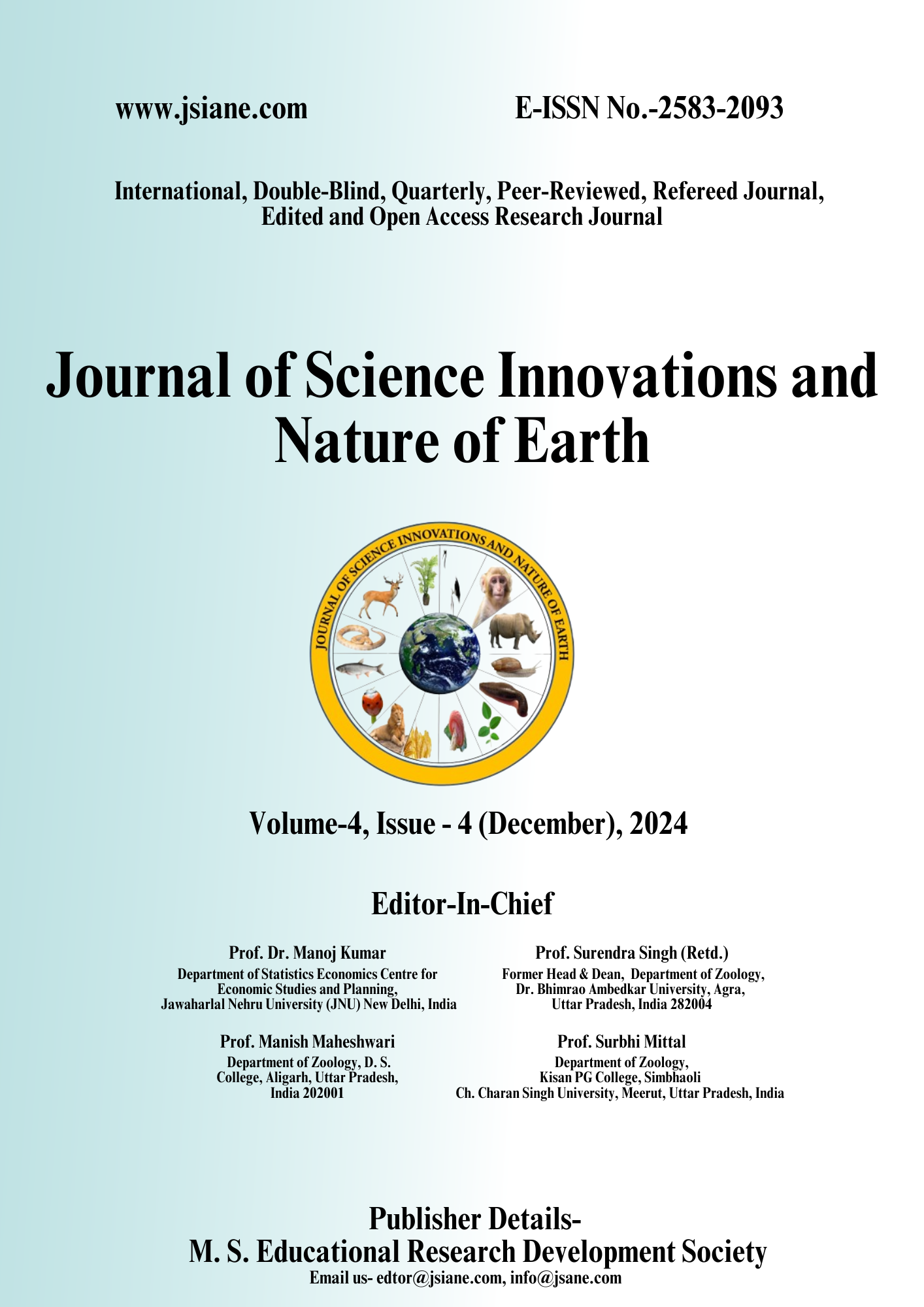Enhancing Accessibility of Laplace Transform for Introductory Mathematics Education
DOI:
https://doi.org/10.59436/jsiane.278.2583-2093Abstract
Through the use of simplification technique, this initiative aims to increase the accessibility of Laplace transform in the development of basic mathematics. This study explores the range of strategic meant to simplify complicated concept for learners. The commitment to improving Laplace transform accessibility is emphasized in the abstract, with the ultimate objectives being the development of a more productive and inclusive learning.
References
Ogata K., et al., 2010. Modern control engineering. Prentice hall Upper Saddle River, NJ, vol. 5.
Deakin M. A., 1992. “The ascendancy of the laplace transform and how it came about,” Archive for History of Exact Sciences, vol. 44, pp. 265– 286,
Michael A. B. Deakin “The development of the laplace transform, 1737-1937: I. euler to spitzer, 1737-1880,” Archive for History of Exact sciences, pp. 343–390, 1981.
Michael A. B. Deakin, “The development of the laplace transform, 1737–1937 ii. poincare to doetsch, 1880–1937,” ´ Archive for History of Exact Sciences, vol. 26, pp. 351–381, 1982.
Carlson A. B. and Carlson B., 2000 Circuits: engineering concepts and analysis of linear electric circuits. Brooks/Cole,
Dorf R. and Bishop R., 2011. Modern Control Systems, 12th ed. Pearson,.
Thomas G. B. Jr, Weir M. D., and Hass J. R., 2015. Thomas’ Calculus: Early Transcendentals. Pearson.
Berezovski T., 2006, “Manifold nature of logarithms: numbers, operations and functions,” in Conference Papers–Psychology of Mathematics & Education of North America, pp. 62–64.
Carstensen A.-K., 2013. “Connect: modelling learning to facilitate linking models and the real world trough lab-work in electric circuit courses for engineering students,” Ph.D. dissertation, Linkoping University Elec- ¨ tronic Press,
Carstensen A.-K. And Bernhard J., 2004 “Laplace transforms: Too difficult to teach, learn, and apply, or just a matter of how to do it?”
Holmberg M. and Bernhard J., 2017 “University teachers’ perspectives on the role of the laplace transform in engineering education,” European Journal of Engineering Education, vol. 42, no. 4, pp. 413–428,
Lundberg K. H., Miller H. R., and Trumper D. L., 2007 “Initial conditions, generalized functions, and the laplace transform troubles at the origin,” IEEE Control Systems Magazine, vol. 27, no. 1, pp. 22–35,.
Chevallard Y., 1999 “L’analyse des pratiques enseignantes en theorie anthro- ´ pologique du didactique,” Recherches en didactique des mathematiques ´ , vol. 19, no. 2, pp. 221–266,.
Drijvers P. and Gravemeijer K., 2005 “Computer algebra as an instrument: Examples of algebraic schemes,” The didactical challenge of symbolic calculators: Turning a computational device into a mathematical instrument, pp. 163–196,
Lagrange J.-B., 2005. “Using symbolic calculators to study mathematics: the case of tasks and techniques,” The didactical challenge of symbolic calculators: turning a computational device into a mathematical instrument, pp. 113–135,
Chevallard, Y. 1992. “Fundamental concepts in didactics,” Research in didactique of mathematics: Selected papers, pp. 131–168,
Artigue M., 2002. “Learning mathematics in a cas environment: The genesis of a reflection about instrumentation and the dialectics between technical and conceptual work,” International journal of computers for mathematical learning, vol. 7, pp. 245–274,
Freudenthal H., 2006, Revisiting mathematics education: China lectures. Springer Science & Business Media, vol. 9.
Chevallard,Y. 2015, “Teaching mathematics in tomorrow’s society: A case for an oncoming counter paradigm,” in The proceedings of the 12th international congress on mathematical education: Intellectual and attitudinal challenges. Springer International Publishing, pp. 173–187.
Boyce W. E., DiPrima R. C., and Meade D. B., 2021. Elementary differential equations and boundary value problems. John Wiley & Sons,
Wunsch A. D., 1983, Complex variables with applications. Addison-Wesley Reading, MA, vol. 204.
Majid, M. A., Huneiti, Z. Balachandran,W. and Balarabe, Y. 2013. “Matlab as a teaching and learning tool for mathematics: a literature review,” International Journal of Arts & Sciences, vol. 6, no. 3, p. 23,
Abou-Hayt, Dahl, I. B. and Rump, C. Ø. 2022. “Teaching transfer functions without the laplace transform,” European Journal of Engineering Education, vol. 47, no. 5, pp. 746–761,
Thornton, R. K. 1997 “Learning physics concepts in the introductory course: microcomputer-based labs and interactive lecture demonstrations,” in Proc Conf on Intro Physics Course. Wiley New York, pp. 69–86.
Reddy K., Kumar, K. Satish, J. and Vaithyasubramanian, S. 2017. “A review on applications of laplace transformations in various fields,” J. Adv. Res. Dyn. Control Syst, vol. 9, pp. 14–24,
Rachlin, S. L. 2018. “The research agenda in algebra: A curriculum development perspective,” Research issues in the learning and teaching of algebra, pp. 257–265,
Bergsten, C., Engelbrecht, J. and Kagesten, O. 2016. “Conceptual and procedu- ˚ ral approaches to mathematics in the engineering curriculum–comparing views of junior and senior engineering students in two countries,” Eurasia Journal of Mathematics, Science and Technology Education, vol. 13, no. 3, pp. 533–553,
Flegg, J. Mallet, D. and Lupton, M. 2012. “Students’ perceptions of the relevance of mathematics in engineering,” International Journal of Mathematical Education in Science and Technology, vol. 43, no. 6, pp. 717–732,
Kent P. and Noss, R. 2003 “Mathematics in the university education of engineers: A report to the ove arup foundation,”
Kumar, P., Tripathee, S. M., & Bhushan, R. (2024). Creating Intuitive Teaching Methods for Advanced Mathematics Education: Original Approaches to Simplify Successive Differentiation. Journal of Science Innovations and Nature of Earth, 4(2), 13-16.
Tripathee, S. M., Dwivedi, A., & Kumar, P. (2024). Innovation in Biomathematics. Journal of Science Innovations and Nature of Earth, 04-06.
Kumar, P. (2021). Herschel-Bulkley Fluid: Study of Rheological Properties for Blood Flow of Pulses in Ω-Prototype in Arteries’stenosis. Journal of Science Innovations and Nature of Earth, 08-16.

Downloads
Published
Issue
Section
License
Copyright (c) 2024 Maharaj Singh Educational Research Development Society

This work is licensed under a Creative Commons Attribution-NonCommercial 4.0 International License.









